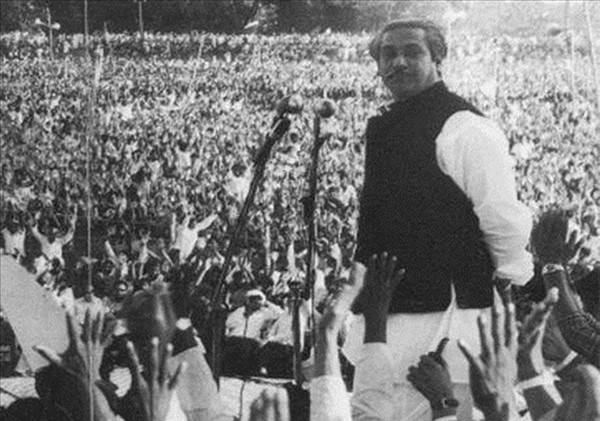
This is a photograph of Awami League leader Sheikh Mujeeb addressing an election rally in Dhaka in 1970, prior to the independence of Bangladesh.
The first general elections in Pakistan were held on December 7, 1970. Voting took place in 300 parliamentary constituencies to elect members of the National Assembly, which was then the only chamber of a unicameral parliament.
Mujeeb’s Awami League won 167 of 169 East Pakistan seats in the National Assembly but none of West Pakistan’s 138 seats. It also won 288 of the 300 provincial assembly seats in East Pakistan. This win gave the Awami League a healthy majority and placed it in a position to establish a national government without a coalition partner.
Meanwhile, in the four provinces of West Pakistan, Zulfiqar Bhutto’s Pakistan People’s Party (PPP) faced severe competition from the conservative factions of Muslim League, the largest of which was Muslim League (Qayyum), as well as slight opposition from the religious parties like JI, JUI and JUP.
The PPP won 81 seats in the National Assembly, but secured the Punjab and Sindh. JUI emerged victorious in Balochistan and the Marxist NAP in NWFP.
The assembly was not called as President Yahya Khan and the PPP resisted Awami League’s attempts to form a government. This caused great unrest in East Pakistan, which soon escalated into a civil war that led to the formation of the independent state of Bangladesh. The assembly session was eventually held when President Yahya resigned and Bhutto took over. Bhutto became the prime minister of Pakistan in 1973, after the post was recreated by the new Constitution.
The first general elections in Pakistan were held on December 7, 1970. Voting took place in 300 parliamentary constituencies to elect members of the National Assembly, which was then the only chamber of a unicameral parliament.
Mujeeb’s Awami League won 167 of 169 East Pakistan seats in the National Assembly but none of West Pakistan’s 138 seats. It also won 288 of the 300 provincial assembly seats in East Pakistan. This win gave the Awami League a healthy majority and placed it in a position to establish a national government without a coalition partner.
Meanwhile, in the four provinces of West Pakistan, Zulfiqar Bhutto’s Pakistan People’s Party (PPP) faced severe competition from the conservative factions of Muslim League, the largest of which was Muslim League (Qayyum), as well as slight opposition from the religious parties like JI, JUI and JUP.
The PPP won 81 seats in the National Assembly, but secured the Punjab and Sindh. JUI emerged victorious in Balochistan and the Marxist NAP in NWFP.
The assembly was not called as President Yahya Khan and the PPP resisted Awami League’s attempts to form a government. This caused great unrest in East Pakistan, which soon escalated into a civil war that led to the formation of the independent state of Bangladesh. The assembly session was eventually held when President Yahya resigned and Bhutto took over. Bhutto became the prime minister of Pakistan in 1973, after the post was recreated by the new Constitution.

